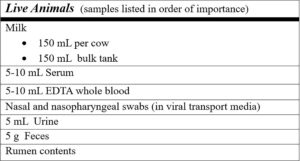3/29/2024: Update on HPAI detections in dairy cattle. The most current press release from USDA Animal and Plant Health Inspection Service (APHIS) can be found here: https://www.aphis.usda.gov/news/agency-announcements/usda-fda-cdc-share-update-hpai-detections-dairy-cattle
——————————————————————————————————————————————————–
On March 25th, the USDA announced that highly pathogenic avian influenza (HPAI) was detected in dairy cattle in several southwestern states. This is the same strain of influenza A that has been circulating in North America since 2022 and is the most destructive foreign animal disease (FAD) outbreak in US history. This strain of HPAI has not yet proven to be the sole cause of illness in these dairy cattle but it is likely associated with the emerging disease outbreak.
There are no confirmed reports of affected dairy cattle in Wisconsin at the time of this report (3/25/2024).
Affected dairies reported cattle with lower feed intake, followed by rapid drop in milk production, and some cows have abnormal milk characteristics. The most common affected cohort of cows are those in the second lactation or greater and are 150 days, or greater, in milk since calving. There are no reports of increased mortality in affected cows. Most cows do return to milk by 10-14 days, but production is muted.
The dairy industry in the US is an interstate business with regular animal movement across state lines, including but not limited to replacements and youngstock being raised far from the home dairy for efficiency and health reasons. The best veterinary medical advice that we have currently is to practice high biosecurity for any animals arriving to the farm. New arrivals should not be in contact with the established herd for at least 21 days and all animals should be monitored closely for feed and water intake. Daily rectal temperatures would be another option for illness surveillance.
Enhanced biosecurity information can be found at www.securemilksupply.org and DATCP: Basic Biosecurity webpage . For the latest information on import rules, please see DATCP: Cattle & Bison Movement webpage.
Any increases from baseline cattle health and illness should be reported to the herd veterinarian as soon as possible. Please also report increased incidence of mortality of birds and/or cats. Veterinarians in Wisconsin should contact the Wisconsin Department of Animal Health, Trade and Consumer Protection (DATCP) for assistance with sample collection to be tested at the Wisconsin Veterinary Diagnostic Laboratory, a National Animal Health Laboratory Network (NAHLN) Level 1 laboratory. Accredited veterinarians can submit samples with prior authorization by DATCP.
Recommendations may change as more diagnostic testing protocols and epidemiological information becomes available. Below are the current requested samples for submission of these investigations. WVDL HIGHLY RECOMMENDS that submitting veterinarians contact WVDL prior to sample collection so that we may facilitate and streamline diagnostics and coordinate with DATCP. Please check back regularly for updates, as this is a working model for this disease investigation.
RECOMMENDED SAMPLES TO COLLECT: Sample 10 affected & 10 unaffected animals

* Call WVDL prior to sample collection & submission.
The USDA, CDC, and FDA have reported that milk from affected cows is safe for human consumption if pasteurized. Beef is also safe for human consumption if properly cooked.
Original APHIS press release can be found at https://www.aphis.usda.gov/aphis/newsroom/news/sa_by_date/sa-2024/hpai-cattle
DATCP Phone: 608-224-5012
WI Department of Animal Health: 608-224-4872
WVDL is here to help, please contact us at any time with questions. Please email at info@wvdl.wisc.edu